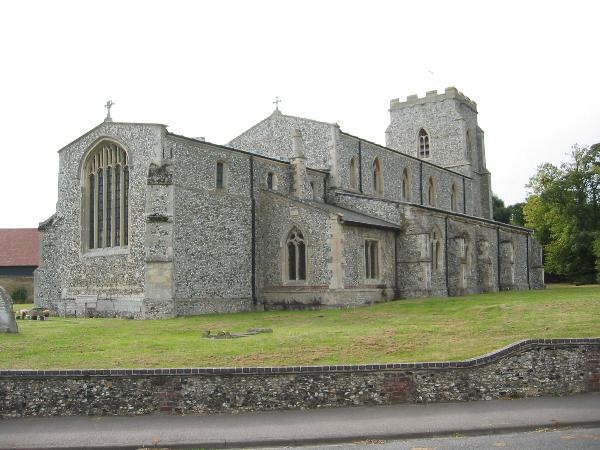
St Catherine's from near the cache site.

Litlington is a picturesque village situated in rural South Cambridgeshire about 3 miles north-west of Royston. It was referred to as Lidlington in the Doomesday Book - as in the town of Lydila. The south of the village is crossed by the ancient Icknield Way; this portion is officially called Ashwell Street and locally as “the Stret”. A 2nd Century high barrow exists at nearby Limlow Hill, the site of an older Iron Age fort. A Roman villa was discovered to the west in 1829 and a few years earlier a Roman cemetery was excavated to the south.
Apart from the church, a noted historical landmark is the village “cage” or “lock-up”. This 18th and 19th century brick structure is probably replacing the much earlier Prison of the Honour of Clare. The last person occupied it in about 1840; a man who set fire to a truss of straw provided for his comfort.
To get to the cage, walk from the church towards the village Post Office, turn left and follow the road for a few yards until you see it on the right.
The Village Cage.

St. Catherine's contains many features of historical interest and is well worth a visit. The view from the road is—in my opinion—a little austere but the views approaching the entrance and from the north-west have all the typical charm of South Cambridgeshire village churches. It is usually open during daylight hours and visitors are encouraged to sign the visitors' book. In fact, visitors are well catered for with good guide leaflets and signs indicating all the interior features.
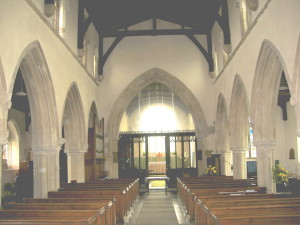
Left - the Nave; Right - the tower from the north-west.
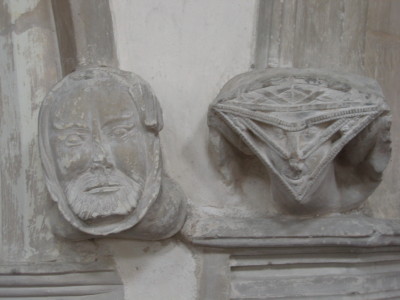
St. Catherine's contains many sculptured stone heads, including a most unusual one of a woman wearing a large 14th century triangular head-dress. One reference suggests that her mouth is clamped shut, although perhaps not by the gentleman to her side. His carving is less detailed and he seems to be a later addition. In fact, his pillar is different from hers, suggesting that it too was erected at a different time. The pair are easy to find near the centre of the Nave.
14th C. veiled head, with her young companion?
St. Catherine's houses two famous examples of graffiti - now over 400 years old - and thought to link two Litlington families with Sir Francis Drake.
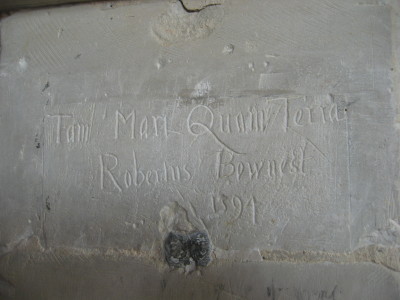
Tam Mari Quam terra Robert Bownest 1594 translates as "as on sea so on land". It has been suggested that Robert Bownest sailed with—or perhaps invested in—Sir Francis Drake’s voyage of August 1595 to harass the Spanish in the Caribbean. Whatever his association was, it seems not to have done him much good; he is said to have become a bankrupt.
Robert Bownest's inscription (behind the Nave organ).
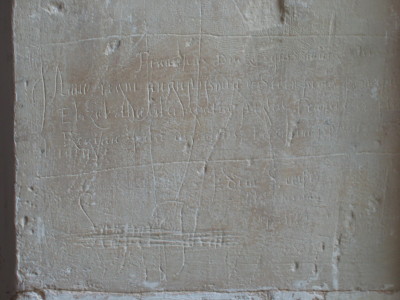
A second inscription reveals more - "Francis Drake, Knight, about to set sail in the thirty-seventh year of the reign of the most august and serene prince, Elizabeth, Queen, by the Grace of God, of England, France and Ireland, Defender of the Faith 1595. The same always. Always the same. John Sherman, April the tenth". The expedition was seriously delayed and plans reached the Spanish who had ample time to arrange a defence. Drake died of dysentery a few months later, with several of his crew.
John Sherman's inscription (window jamb to east of main entrance).
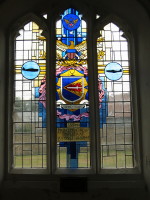
Not all features of the church are so old. In the chancel can be found a stained glass window dedicated to the 355th Fighter Group of the USAF who were stationed in the village during the Second World War. It was made and donated by John Dobbertin of Woodstock, Illinois and includes British and German glass in its construction.
You may care to follow that theme and visit "Footsteps of Flying Heroes" (GCWCA7) which is a short distance to the west.
355th Fighter Group memorial (Chancel).
It is possible to park close to the church and the cache. If you'd like to extend your stop-off a little, there's a pub a few yards up the road and a post office/grocery shop. Alternative parking can be found there too.
If anybody would like to expand this series please do, I would just ask that you could let Sadexploration know first so he can keep track of the Church numbers and names to avoid duplication.